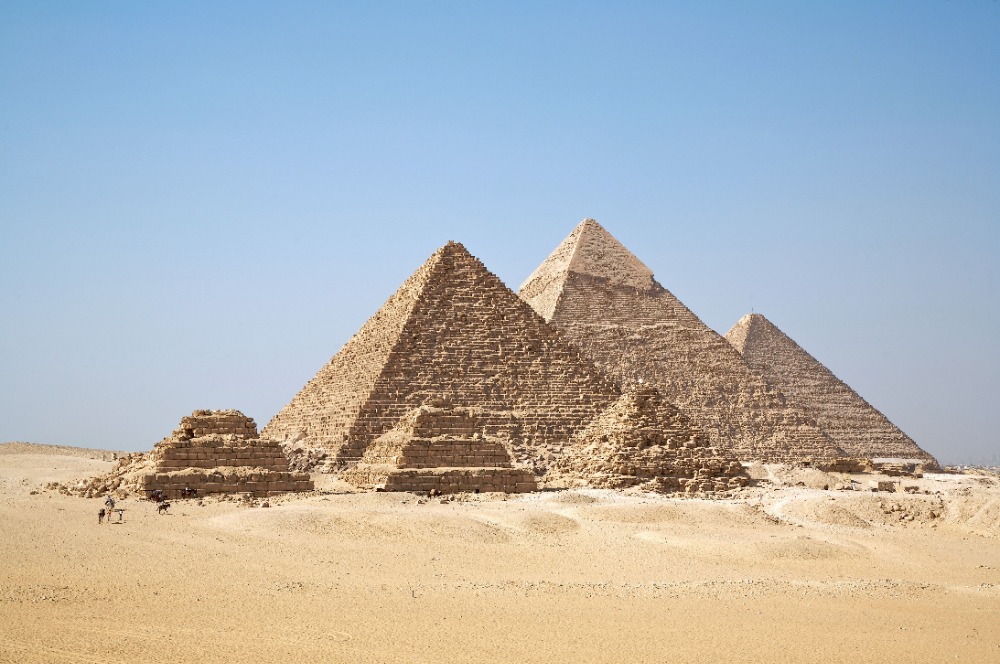
Article posted by
Pyramids have been symbols of awe and wonder for millennia, and many of their riddles have yet to be solved – the Pyramids of Giza are no different.
Situated on a natural rocky outcrop on the western bank of the River Nile in Northern Egypt, the three colossal structures date back to around 2,550 BC and were built in a frenzied period lasting a little over 100 years.
The biggest, the Great Pyramid, is the only one of the seven wonders of the ancient world still in existence and, at some 139 meters high, is the largest pyramid ever built. Erected as a mausoleum for the second king of the fourth dynasty of the Egyptian Old Kingdom, it is alternatively known also as the Pyramid of Khufu.
The son of Sneferu, Khufu (or Cheops in Greek) is thought to have ruled for 23 years between 2589-2566 BC, and modern Egyptologists estimate construction of his pyramid took 20 of them.
The second was built for Khufu’s son Khafre, the structure only marginally shorter in height and still topped with the original smooth casing limestone that once covered all three pyramids—long gone following a great earthquake in 1303 AD and then removed en masse to build mosques and fortresses in nearby Cairo. Khafre’s necropolis is also the site for the legendary Sphinx. The third pyramid is significantly smaller and was constructed for another descendant of Khufu, Menkaure.
The Construction
Just how structures of such magnitude were built in ancient times is a question that has baffled historians for many years.
The Pyramid of Khufu alone is made up of around 2.3 million blocks of stone, each weighing around 2.5 to 15 tonnes. For a civilisation that were not even using the wheel at the time the pyramids were constructed, merely transporting the colossal blocks would have been a mammoth undertaking. Then to manoeuvre them into position in the 5,750,000 tonne edifice was a work of engineering genius.
The problem is so multifaceted there are a slew of theories on how it was achieved. The writings of Greek historians Herodotus and Diodorus Siculus claim that some 100,000 slaves brought the stones from as far away as Arabia on rollers.
More modern concepts have suggested between 20,000 to 25,000 workers were needed to bring the blocks from a quarry a short distance to the south-east of the site and, rather than being slave labour, the workers were in fact a mix of skilled masons and artisans, along with secondary labourers who built immense ramps up the sides of the pyramids to put the stone in place.

A more contentious idea was theorised in 1974 by French scientist Joseph Davidovits who suggested the blocks were cast in situ, using a large scale batch mixing of a type of concrete, but analysis on the make up of the stones in 2006 concluded this was unlikely.
And of course, the notion the ancient Egyptians received a helping hand from alien visitors has been doing the rounds since Erich Von Däniken’s bizarre book Chariots of the Gods in 1968. Conspiracy theorists point to the Great Pyramid’s coordinates of 29.9792458°N and the speed of light (299,792,458 metres per second) as evidence that extra-terrestrials left us a message, and surmise that a people who had not yet discovered the wheel were incapable of building something as incredible as the pyramids.
New Discoveries
The ancient structures continue to excite the imagination of people all over the world, and new discoveries about them are continuously being made. Earlier this month a Russian team speculated the Great Pyramid might be able to focus electromagnetic waves into pockets of higher energy in its inner chambers and beneath its base. The scientists hope to recreate the effect on a nanoscale for use in creating effective solar cells.
There is no doubt the World Heritage Site of the Pyramids of Giza remains one of the most fascinating mysteries on earth, with an allure that has lasted for over 4,500 years.
We’re here if you need help defining a role or brief, specialist insight to help shape your ideas or expert help with your recruitment process. Just get in touch to arrange a conversation with one of the team or if you’re ready for us to find the perfect person for you, send us your brief.
If you’re looking for your ideal job send your CV to us to get started or search for the latest job vacancies and we’ll get the ball rolling.